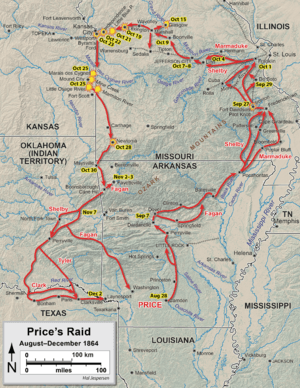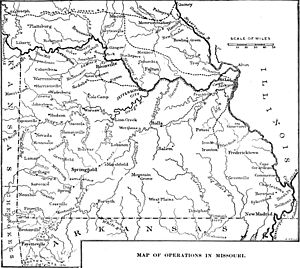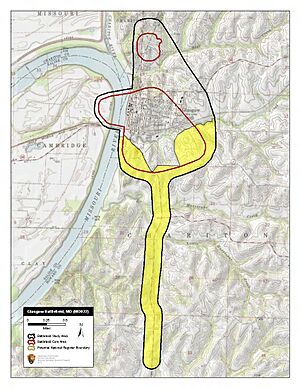Battle of Glasgow, Missouri facts for kids
Quick facts for kids Battle of Glasgow |
|||||||
|---|---|---|---|---|---|---|---|
| Part of the American Civil War | |||||||
|
|||||||
| Belligerents | |||||||
| Commanders and leaders | |||||||
| Strength | |||||||
| 550–800 | c. 1,825 | ||||||
The Battle of Glasgow happened on October 15, 1864, in and around Glasgow, Missouri. It was part of Price's Missouri Expedition during the American Civil War. In this battle, the Confederate army won. They captured important weapons and felt much better about their chances after a loss at the Battle of Pilot Knob.
Contents
Why the Battle Happened
Missouri's Role in the Civil War
When the American Civil War began in 1861, Missouri was a state where slavery was allowed. However, it did not officially leave the United States. The state was divided. The governor and the state militia supported the Confederacy. But the Union Army supported the United States and wanted to stay in the Union.
By 1862, the Union gained control of Missouri. After this, most Confederate actions in the state were small attacks and guerrilla warfare (small groups fighting using surprise attacks).
Why Price Invaded Missouri
By late 1864, the Confederates were losing the war in the eastern United States. General Edmund Kirby Smith, a Confederate leader, wanted to help. He decided to send an army into Missouri. This would make the Union move their soldiers away from the main battles in the east.
Major General Sterling Price was chosen to lead this attack. He hoped to start an uprising against Union control in Missouri. He also wanted to help a presidential candidate who favored ending the war. On September 19, Price's army, called the Army of Missouri, entered the state.
Before the Battle
Price's Journey to Glasgow
Price's army had about 13,000 cavalry (soldiers on horseback). Many of them did not have good weapons. They also had 14 small cannons. The Union army in Missouri had fewer than 10,000 men. Many of these were militiamen (citizen soldiers) with little battle experience.
Price's army first met a small Union force at Pilot Knob. The Confederates attacked but lost many soldiers. The Union troops left the fort that night. Price then decided not to attack St. Louis. He also saw that Jefferson City was too strong to attack. So, he moved his army west along the Missouri River.
New Recruits and a Plan
Price's army reached Boonville on October 9. This area was known as "Little Dixie" and had many Confederate supporters. Many men joined Price's army there. But many of these new soldiers did not have weapons.
On October 12, Price heard a rumor. He heard that the Union army had a large store of weapons in Glasgow. Glasgow was across the Missouri River, about 20 miles north of Boonville. Price decided to send a group of soldiers to capture these weapons.
The Battle of Glasgow
Confederate Attack Plan
Brigadier General John B. Clark Jr. led the Confederate attack on Glasgow. He had about 1,700 to 1,800 men. Another Confederate leader, Joseph O. Shelby, also sent some cavalry and cannons to help. These cannons were placed on the other side of the river from Glasgow.
The Union soldiers in Glasgow were led by Colonel Chester Harding Jr.. He had between 550 and 800 men, including armed civilians. The Union forces had no cannons. Glasgow was on a hilltop, which gave the defenders an advantage. Harding's men set up defenses around the town.
Fighting Begins
Around 5:00 AM on October 15, the Confederate cannons across the river started firing. They aimed at a Union steamboat and campfires. The firing was not very effective at first.
Clark's main force arrived later than planned, around 7:00 AM. They began to set up their attack. Clark sent a message to Harding, asking him to surrender. Harding was confused by the message and refused.
The Main Attack
Around 8:00 AM, Clark's main force attacked the Union lines south of town. The Union defenders fought hard but were pushed back into Glasgow. The Confederate cannons across the river became more effective. The Union steamboat, West Wind, was damaged.
Confederate troops moved closer to the Union lines inside Glasgow. There was intense fighting from house to house. Harding held a meeting with his officers. They decided to surrender.
Before surrendering, the Union soldiers burned 50,000 food rations in Glasgow's City Hall. They did this to stop the Confederates from getting them. The fire spread and caused a lot of damage to other buildings. The surrender happened around 1:30 PM. The Union soldiers were allowed to keep their horses and small weapons. They were also released, promising not to fight against the Confederates again.
What Happened Next
The Confederate victory at Glasgow was a big boost to their spirits. They had captured much-needed supplies. This was especially important after they failed to take St. Louis or Jefferson City.
However, Price's army continued to move through Missouri. On October 23, they suffered a major defeat at the Battle of Westport. This loss convinced Price to leave Missouri. His army was chased by Union troops as they retreated through Kansas and Arkansas. Price could not get enough new soldiers to replace his losses. The Union army had a very strong hold on Missouri. Because of this, Price's raid was ultimately not successful. The Battle of Glasgow was a small win, but it did give Price's army important supplies.
See also
 In Spanish: Batalla de Glasgow para niños
In Spanish: Batalla de Glasgow para niños




